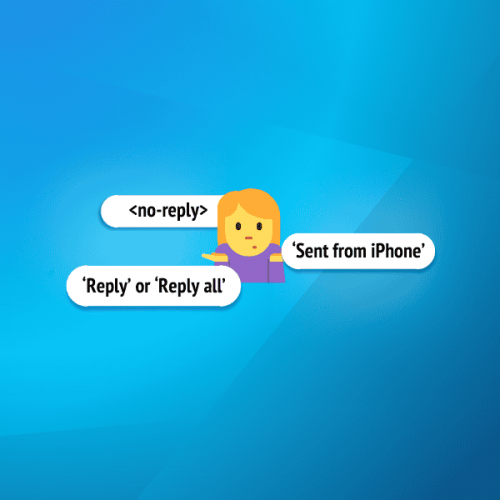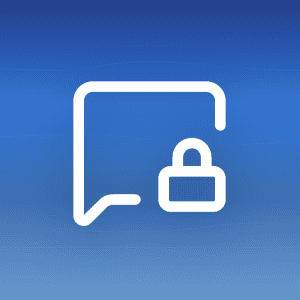Back in the day, people really cared about good manners. But these days, it feels like some of us have lost track of these good habits. Let’s start remembering them, beginning with how we communicate in our emails.
Here are 15 etiquette guidelines you should follow when replying to an email.
Get the latest privacy news in your inbox
Sign up to the Mailfence Newsletter.
1. Always reply, never ignore
We get it. Not all emails bring cheerful news.
It could be about a deal that didn’t go through, or perhaps you’re being laid off from your job, or it could be any other bad news.
You may wonder, “Why should I respond to this email when the decision is final and can’t be changed?”.
That’s a fair point. However, it’s always good to leave a positive impression. There’s a chance people might reconsider or remember you when another chance comes up.
So, the least you could do is confirm that you got their email, even if it’s just by saying, “Thanks for letting me know.”
Naturally, if the email is from a no-reply address, you don’t need to respond.
2. Don’t leave them hanging for an email reply
Emails are usually slower than instant messaging, and they have their own set of rules.
Viber reports that people usually reply to text messages in 90 seconds, and 95% of texts are read within 3 minutes after they’re sent.
Now, compare that to how long it takes people to answer an email. According to a report by Email Analytics in January 2023, the average response time for an email is around 11 hours and 40 minutes including weekends and non-work hours, or about 3 hours and 43 minutes during just work hours.
See the big difference?
In instant messaging, if someone doesn’t respond in three hours, it feels like they’re not paying attention. But with email, that’s pretty normal.
However, you can’t take forever to answer your emails. A survey of 1,500 people showed that 52% of them expect a reply to a work email within 12 to 24 hours.
When it comes to customer emails, people expect even faster replies: 41% of people want a response within six hours.
So, even though you have a bit more time to answer emails, try to respond within 24 hours after getting the message.
3. Don’t skip questions
You may not know all the answers, and that’s perfectly fine. But remember, just because you avoid certain questions doesn’t mean the other person will forget about them.
Selectively answering only the convenient questions is not the right approach. Instead, admit if you don’t know an answer. Ask for some time to find it (“I’ll get back to you on that”) or direct them to someone who does know, by including that person in the email thread (using CC for example).
4. Avoid replying to emails when you’re on the CC Line
Talking about CC or “Carbon Copy,” it’s an excellent way to connect people via email.
The CC line has its own set of rules. A common one is that you typically don’t reply if you’re just in the CC line.
Like all rules, there can be exceptions: For example, sometimes you may be invited to join the discussion.
However, most of the time, it’s best to let the people in the “To” line do most of the talking.
5. Can’t respond yet? At least acknowledge the email
There might be times when you need a bit more time or you’re still trying to find the answers that someone else is asking for.
That’s perfectly fine. But it’s still good to a least acknowledge the email with a simple “Thank you for your message. I’ll get back to you shortly.”
6. Don’t waste the sender’s time
There are two main ways to waste the sender’s time regarding email replies.
The first, as you might expect, is when you’re taking too long to reply to an email from them.
The second is to reply quickly but not get to the point fast enough.
Here’s a tip: always say the most important thing first, then give extra details if you need to. Don’t do it the other way around. People don’t want to read the storytelling before they get to the part that really matters.
7. Stick to the subject
While you might want to switch to a different topic, it’s best to stay focused on the subject in your current email thread.
If there’s something else you need to talk about, it’s better to send a new email and start a fresh conversation, but keep the current one on track.
This approach makes sense for a practical reason too.
For instance, imagine you have an email thread discussing last quarter’s sales, and you suddenly share an important update. This important news might get lost in the sales conversation, and there’s a good chance people will overlook it.
8. Don’t forget attachments (but only if they’re relevant)
Email attachments are not always necessary; depending on the email, you might not need them.
But when the situation requires an attachment, don’t omit it.
One of the most embarrassing moments you can have is to write something like “Please find attached” or “attachment enclosed” and then forget to add the attachment.
9. Double-check who you’re responding to
There are two mistakes that you can do when responding to someone that can be solved by a simple double-check.
The first one is responding to the wrong email address. This usually happens if you misspell the address. For example, instead of pat@email.com, you might be sending an email to pit@email.com.
Another common error is replying to the wrong person in the thread. For example, if Susan asks you a question, don’t respond to Mark by mistake. This could confuse both of them – Susan might think you’re ignoring her question, and Mark might wonder why you’re answering a question he didn’t ask.
10. Use “Reply All” Sparingly
Do you know if what you’re about to say is relevant to everyone in the thread or just to one or a few people?
If you’re unsure, don’t click “Reply all.” Instead, only reply to the person(s) for whom your answer is relevant. Otherwise, you’ll needlessly fill up other people’s inboxes.
This article explains in detail when to use the “reply all” function.
11. Always take the time to spell-check your email reply
Emails are mainly used for work-related exchanges these days, so it’s really important to come across as professional.
One thing that doesn’t look professional is having spelling or grammar mistakes in your emails.
You can easily avoid this by reading over your email before you send it.
There are a lot of free spell-checker tools such as Grammarly that fix or highlight misspelled words. But you shouldn’t just rely on this. It’s always a good idea to do your own proofreading.
12. Avoid slang, abbreviations, and emoticons
Slang, abbreviations, and especially emoticons have become a standard way of communication via text. But while sending someone a “LOL” or a winking smiley face is perfectly fine in chat or SMS, this has no place in professional email communication.
13. Mind your email tone
In face-to-face conversations, it’s easier to express your tone using facial expressions, body language, and changes in your voice. These are all important parts of social interaction.
But with written communication, like emails, you don’t have any of those.
Texts or chats might be a bit easier because you can use casual language and even emojis. But with formal emails, as we’ve discussed before, this isn’t really proper.
Even so, you still need to find the right tone for your emails. This can be tricky, as there aren’t any strict rules. Generally, you should keep your tone professional, friendly, and respectful. However, how “friendly” your tone is really depends on the situation.
For example, if you know the person well, it’s okay to have a more casual and friendly tone. But if it’s your first time communicating with them, it’s better to stick with a more formal tone.
14. Respect work hours
Unless it’s an emergency, try to respect working hours. If you’re emailing someone in a different time zone, be mindful of their work schedule.
15. Keep confidential information safe
Always double-check the recipient’s email address before sending sensitive information. A minor typo could result in the email going to the wrong person, potentially causing a security issue.
Remember, protecting confidential information isn’t just about preventing data breaches, it also maintains trust with clients, employees, and business partners.
If you have to send private or sensitive information like financial details, personal data, or internal company documents, it’s important to ensure these communications are secure.
Avoid sending such information through email unless it’s encrypted. Email encryption transforms the content of your email into scrambled text which can only be read with the right encryption key.
Conclusion
Emails have been with us for a long time, but understanding how to use them correctly can be tough. Hopefully, these 15 email reply rules have cleared some of the confusion you might have had when responding to your emails.
Want to learn even more about email etiquette?
Check out our “Ultimate Guide of Email Etiquette” for more useful tips and tricks!



